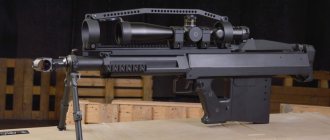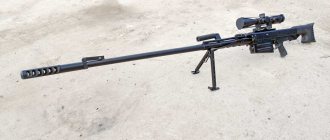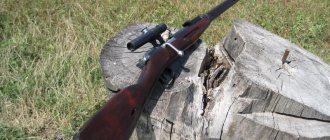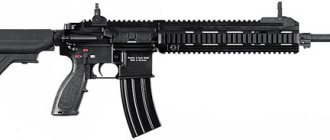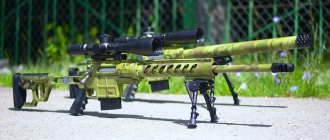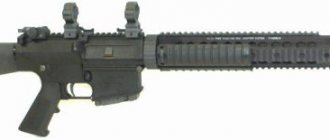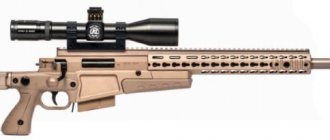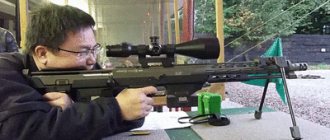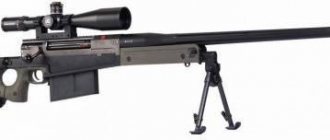Rifles and carbines of the Carcano system
Modello 1891 rifle (better known as the Carcano , or Parravicino-Carcano ) was the main Italian rifle of the First and Second World Wars. It was produced in versions of both the rifle itself (Italian: Fucile) and the carbine (Italian: Moschetto).
History of creation
The Italian Model 1891 rifle of the Paraviccini-Carcano system ( Modello 1891 Paraviccini-Carcano ), also erroneously called Mannlicher-Carcano , was developed by engineer Salvatore Carcano at the state arsenal in Terni and adopted by a commission led by General Paraviccini . Along with the rifle, new 6.5 mm caliber cartridges (6.5×52) with a sleeve without a rim and a long, relatively blunt-pointed jacketed bullet were also adopted. The name of the famous Austrian weapons designer Ferdinand Von Mannlicher is associated with this rifle because it uses his burst-loading system magazine, albeit modified. Otherwise, the Carcano system rifles have very little in common with the Mannlicher rifles.
Italian soldiers in training
M91 rifles were produced in both infantry and carbine versions. In 1938, based on the experience of fighting in North Africa, the 6.5x52 cartridge was considered insufficiently powerful, and based on its cartridge case, a new 7.35 mm cartridge with a pointed jacket bullet was created. Carcano Modello 1938 system rifle was created for this ammunition , designed to replace both rifles and carbines. The outbreak of World War II prevented the transition to a new ammunition, and in 1940 the Italians returned to the 6.5x52 cartridge as their main one. Modello 38 rifles were re-barreled for the old cartridge, and some Modello 91 were “shortened” to the Modello 38 standard while maintaining the original caliber. A number of Carcano rifles were chambered for the German 7.92x57 Mauser cartridge; these rifles were used by Italian units fighting in North Africa.
Options and modifications
- Fucile di Fanteria Mod. 1891 - “infantry rifle of the 1891 model”, adopted for service in March 1892, chambered for 6.5x52 mm. Total length: 1282 mm. Barrel length: 780 mm. Weight: 3.78 kg. Food was provided by a pack of 6 rounds. Sight at 2000 m. The weapon was equipped with a cleaver bayonet.
- Moschetto da Cavalleria Mod. 1891 - a carbine developed in the summer of 1893 for cavalrymen and mounted gendarmes. Total length: 953 mm. Barrel length: 450 mm. Weight: 3.06 kg. Sight at 1500 m.
Carbine Moschetto Mod. 1891 - Moschetto Mod. 1891 per Troupe Speciali (Mod. 1891 TS ) - a carbine for sappers, signalmen and artillerymen, which appeared in 1897. In general, it is identical to the cavalry model, but has a weight of 3.22 kg and a cleaver-type bayonet. Bayonet for carbine Carcano Mod. 1891 TS
Another curious feature of the weapon was that they had progressive rifling of the barrel, that is, rifling with an increasing pitch, the steepness of which gradually increased in the direction of the muzzle. The British gunsmith Metford initially experimented with such rifling, but he soon abandoned them, because their advantages did not compensate for the significant difficulties in the process of manufacturing weapons using the production technologies of that time.Rifles of the 1891 model had barrels with progressive rifling; since 1938, all rifles of both 6.5 mm and 7.35 mm calibers had barrels with a constant rifling pitch.
It is interesting that although the vast majority of armies in the world followed the Germans in switching to pointed bullets, the Italians retained blunt-pointed bullets for their 6.5x52 mm cartridges. This is explained by the fact that the Italian 6.5 mm bullets had a large lateral load (the ratio of mass to the cross-sectional area of the bullet), and as a result, a good trajectory flatness, and also gave low recoil.
Italian alpine riflemen armed with 6.5 mm Carcano Moschetto Mod carbines. 1891, on the march.Among the minor design defects of the Italian rifle, one can note an insufficiently perfect bolt delay, a simple stock neck and too wide and heavy sling swivels.
Operation and combat use
If at the turn of the 19th and 20th centuries the Carcano rifle was not only not inferior to rifles of other systems, but was also superior in some respects, then at the time Italy entered World War II it was an obsolete weapon. To some extent, the history of the appearance of the latest modifications of the Carcano rifle reflects the state of Italian politics, economics and the military industry of that time. The state was not only unable to adopt any of the proposed options for new infantry weapons, including semi-automatic ones, but it was simply unable to organize the production of rifles chambered for the new 7.35 mm caliber cartridge.
- Italy - the main Italian rifle of the First and Second World Wars.
Italian soldiers with Carcano Mod rifles. 1891 - Greece — captured rifles and carbines were in service with the partisans.
Greek partisans in the ranks. The girls are armed with captured Italian rifles, the third girl from the right is armed with a 6.5 mm Italian Breda Mod machine gun. thirty - Spain - during the war in Spain, captured rifles of the Italian Expeditionary Force were used by the Republicans; After more than 3 thousand Italian rifles and more than 5 million cartridges for them were captured during the battle of Guadalajara in March 1937, several brigades of the Republican Army were completely rearmed with Italian rifles.
- China - in 1920-1930. A number of 6.5 mm Italian Carcano rifles and carbines were used by paramilitary forces in China.
- Third Reich - after the surrender and withdrawal of Italy from the war in 1943, the Italian units were disarmed by the Germans, their weapons were placed at the disposal of the German military command.
- Ethiopia - a number of captured rifles captured during the wars of 1895-1896. and 1935-1936, used in the Ethiopian army.
- Yugoslavia - After the end of the First World War, Carcano rifles remained in army mobilization reserve warehouses until the occupation of Yugoslavia in April 1941. Subsequently, these rifles were used by the paramilitary forces of the Croatian Ustasha and the partisans of the NOLA.
Bulgaria - in 1935, Mussolini gave Bulgaria 5 thousand old Italian Carcano Mod rifles free of charge. 1891 and a supply of cartridges for them, which were transferred to the warehouses of the mobilization reserve of the Bulgarian army; After the outbreak of World War II, the size of the Bulgarian army began to increase; rifles from the warehouses of the mobilization reserve were transferred to the arsenal of the emerging units. In 1943, a number of Italian rifles were still in service with auxiliary security and police forces (in particular, rural guards).
Video
Rifle shooting, weapon handling, etc.:
Moschetto Mod. 1938 TS
| TACTICAL AND TECHNICAL CHARACTERISTICS | |||
| Model: | Fucile di Fanteria Mo. 1891 | Moschetto Mo. 1891 | Moschetto Mo. 1938 TS |
| Manufacturer: | Fabbrica Armi Esercito di Terni (FAET), etc. | Fabricca d'Armi di TerniArmaguerra | |
| Cartridge: | 6.5x52 mm Carcano | 7.35×51 mm Carcano | |
| Caliber: | 6.5 mm | 7.35 mm | |
| Weight without cartridges: | 3.708 kg | 3.06 kg | 3.4 kg |
| Weight with cartridges: | n/a | ||
| Length: | 1282 (with 1590 bayonet) mm | 953 mm | 1015 (with bayonet 1190) mm |
| Barrel length: | 780 mm | 450 mm | 540 mm |
| Number of rifling in the barrel: | 4 right-hand | ||
| Trigger mechanism (trigger): | Impact type | ||
| Operating principle: | Rolling bolt | ||
| Fuse: | Flag at the rear of the bolt | ||
| Aim: | Front sight and rear sight, adjustable in range | Front sight and fixed rear sight at 300 m | |
| Effective range: | 500 m | 300 m | |
| Sighting range: | 2000 m | 1500 m | |
| Initial bullet speed: | 700 m/s | 685 m/s | |
| Type of ammunition: | Permanent magazine, burst loading | ||
| Number of cartridges: | 6 | ||
| Years of production: | 1891–1945 | 1938–1945 | |
Caliber history: Kennedy bullet – 6.5×52 mm Carcano
A story of conspiracy or irony of fate. We tell you how a cartridge for the US President ended up in the hands of a killer
On November 22, 1963, President John F. Kennedy's motorcade passed the Texas Book Depository building. Seconds later, three shots changed the history of the United States and the world forever. From the point of view of sniper art, the shooting was difficult, but not prohibitive - the distance was short, the presidential limousine drove slowly so that Kennedy could greet the assembled crowd. And although Kennedy's death remains fertile ground for various conspiracy theories (former Los Angeles District Attorney Vincent Bugliosi even estimated that a total of 42 groups, 82 killers and 214 people were charged with them), the official version still goes as follows: , that all the work was done by former Marine Lee Harley Oswald and 6.5 mm bullets from a Fucile di Fanteria Mod rifle. 91/38, also known in the West under the not entirely correct name “Mannlicher-Carcano” (Mosin is not the only one who has no luck with the name).
Of course, since then, many people have tried to somehow reproduce Oswald's shots, or at least try to understand whether he really could have killed the President of the United States at that moment and with the weapons that he had. Writer Stephen Hunter, author of a series of novels about the sniper Swagger, did not escape this hobby.
“So in 1891 the Italians understood that their most important battles would be defensive in nature.
They will not invade, they will be invaded, and their job will be to stop the oncoming invasion. Where will these battles take place? The sea landing had not yet been worked out: no one even tried to do this, so the opponents - the Germans or the Austrians, obviously - would go by land. If you look at the map, it will tell you a lot: the invasion will have to go through the Alps. This will be a mountain war. ... Who was the Italian soldier going to shoot at in the mountains? The intended enemy was a German or Austrian mountain shooter, trained in rock climbing, athletic, with a high pain threshold, in excellent physical condition - an elite fighter. And one more key feature: he will be tightly dressed. Underwear, underpants, thick wool trousers, equally thick wool shirt or uniform light jacket, sweater, thick leather or fleece vest, thickly lined outer jacket (there was no Gore-Tex in those days), all tightly secured with buckled straps . What needs to be done to kill him?
We need to pierce all this with him. The bullet must reach it with enough energy so as not to be deflected when it hits a button, belt or flask and not to fall apart when it hits a bone, but to penetrate deep into: to the heart, lungs, intestines, which are located deep under all the insulation. It was for this task that the Mannlicher-Carcano bullet was made and it was precisely this job that the WC399 performed on November 22, 1963. There was no anomaly here. This absolutely inexorably followed from the characteristics laid down during its creation.”
As they say, this is the truth, but not the whole truth. Firstly, the Italians quite easily waged colonial wars in Africa and even managed to become the first European country to suffer a major defeat in the colonies. The Battle of Adua is less known than the Battle of Isandlwana, but if the Zulus defeated only a regiment with a total strength of less than 2000 people and ultimately lost the war, then at Adua the entire Italian expeditionary force was defeated, and in order to free the prisoners, Italy was forced not only recognize the independence of Ethiopia, but also pay indemnity.
Secondly, the very early rifles designed by Salvatore Carcano had a very interesting sector sight, designed for a distance from 420 to 2000 meters, since the military theories of that time allowed for the possibility of long-distance salvo shooting at group targets. But the practice of the First World War quite convincingly showed the fallacy of these views. Moreover, even the slot on the block for a distance of 300 meters turned out to be not the best solution - this led to a significant increase in the height of the bullet at closer distances and probably saved the lives of many Austrian soldiers whose heads the Italians were aiming at. As a result, the modified rifles were equipped with a fixed and non-adjustable sight, designed for a single distance - 200 meters. It was simple, reliable and as fool-proof as possible. By the way, one of the theories explaining Oswald’s rapid shooting suggests that the shooter did not use an optical sight, but a mechanical sight, which was more familiar to him from his training in the Marine Corps.
As for the rifle itself and the cartridge, the Italians really looked at their neighbors for a long time - both at the Swiss experiments with small-caliber (according to the concepts of that time) long-range bullets, and at the Austrians. In principle, they liked both the Mannlicher rifle and the Swiss cartridge, but the prospect of paying for a license...
As a result, as mentioned above, the rifle (albeit with an eye to Mannlicher) was created by Salvatore Carcano. However, the fluidity of ideas is a mutual matter, and it is not at all excluded that Ferdinand Ritter von Mannlicher himself also created his 6.5x53R not without looking at early Italian experiments with cartridge cases that had a rim. The Italians themselves eventually abandoned the rim, as well as Nobel’s early nitroglycerin powders. The main “filling” for the cartridge was solenite with a low percentage of nitroglycerin. This greatly reduced barrel erosion and increased the service life of the rifle. In addition, the Italian cartridge had a lower operating pressure than its counterparts in other countries. In combination with high-quality barrel steel (partially purchased in the Czech Republic at the Kladno foundry) and deep rifling, this allowed Italian rifles to maintain high combat characteristics for a long time, including accuracy. The large relative length, combined with the caliber, gave the bullet good stability in flight.
However, the 6.5x52 mm Carcano was not entirely ideal either. While other countries already modified their cartridges at the beginning of the 20th century, switching to a more aerodynamically optimal pointed shape, the Italians remained faithful to the blunt tip until the very end of production. The sharp noses had armor-piercing versions, tracers and special bullets of increased accuracy.
Part of this loyalty was due to the emergence of a more effective 7.35 x 51 mm cartridge in the Italian army, but the “works - don’t mess with it” factor could also play a role. By the way, this is also one of the clues for conspiracy theorists who claim that a more modern sharp-nosed bullet was found at the site of Kennedy’s assassination.
Here you can see that the “Dallas bullet” may actually have been made in the USA - although not in the sense that conspiracy theorists assume. In the late 1940s, Western Cartridge produced a batch of 6.5x52mm Carcano ammunition for supply to Greece as part of American military assistance to government forces fighting pro-communist guerrillas. According to known information, Lee Harley used cartridges from this batch. One can see the irony of fate in this - President Kennedy, who diligently pursued a policy to contain communism and counter communist movements in the world, was killed by a bullet commissioned by the American secret services to fight communism.
Carcano M1891. Italian infantry rifle of the First World War "Carcano model 1891"
The Modello 1891 rifle (better known as the Carcano, or Parravicino-Carcano) was the main Italian rifle of the First and Second World Wars. It was produced in versions of both the rifle itself (Italian: Fucile) and the carbine (Italian: Moschetto). The Italian Model 1891 rifle of the Paraviccini-Carcano system (Modello 1891 Paraviccini-Carcano), also erroneously called Mannlicher-Carcano, was developed by engineer Salvatore Carcano at the state arsenal in Terni and adopted by a commission led by General Paraviccini. Along with the rifle, new 6.5 mm caliber cartridges (6.5x52) with a sleeve without a rim and a long, relatively blunt-pointed jacketed bullet were also adopted. The name of the famous Austrian weapons designer Ferdinand Von Mannlicher is associated with this rifle because it uses his burst-loading system magazine, albeit modified. Otherwise, the Carcano system rifles have very little in common with the Mannlicher rifles. M91 rifles were produced in both infantry and carbine versions. In 1938, based on the experience of fighting in North Africa, the 6.5x52 cartridge was considered insufficiently powerful, and based on its cartridge case, a new 7.35 mm caliber cartridge with a pointed jacket bullet was created. A short version of the Carcano Modello 1938 system rifle was created for this ammunition, designed to replace both rifles and carbines. The outbreak of World War II prevented the transition to a new ammunition, and in 1940 the Italians returned to the 6.5x52 cartridge as the main one. The released Modello 38 rifles were re-barreled for the old cartridge, and some Modello 91 infantry rifles were “shortened” to the Modello 38 standard while maintaining the original caliber. A number of Carcano rifles were chambered for the German 7.92x57 Mauser cartridge; these rifles were used by Italian units fighting in North Africa. Options and modifications: • Fucile di Fanteria Mo. 1891 - “infantry rifle of the 1891 model”, adopted for service in March 1892, chambered for 6.5x52 mm. Total length: 1282 mm. Barrel length: 780 mm. Weight: 3.78 kg. Power was provided by a cartridge pack of 6 rounds. Sight at 2000 m. The weapon was equipped with a cleaver bayonet. • Moschetto da Cavalleria Mo. 1891 - a carbine developed in the summer of 1893 for cavalrymen and mounted gendarmes. Total length: 953 mm. Barrel length: 450 mm. Weight: 3.06 kg. Sight at 1500 m. • Moschetto per Truppe Speciali Mo. 1891 (abbr. Mo. 1891 TS) is a carbine for sappers, signalmen and artillerymen, which appeared in 1897. In general, it is identical to the cavalry model, but has a weight of 3.22 kg and a cleaver-type bayonet. • Moschetto di Fanteria Mo. 1891/24 - in 1924, rifles, the muzzle of which was badly worn, were converted into carbines by shortening the barrel to 453 mm. • Moschetto per Truppe Speciali Mo. 1891/28 - modification of the Mo carbine. 1891 TS, produced since 1928. It had a barrel length of 457 mm and a standard rifle bayonet. Also for this carbine, the Tromboncino Mo grenade launcher was developed in 1928. 28 caliber 38.5 mm. • Type I Rifle - an export version of the rifle chambered for 6.5x50 mm, purchased by the Japanese Navy in 1938-39. • Fucile di Fanteria Mo. 1938 - rifle of the 1938 model chambered for 7.35x51 mm. Barrel length: 563 mm. Magazine capacity 6 rounds. Fixed rear sight at 300 m. • Moschetto Mo. 1938 and Moschetto Mo. 1938 TS - carbines of the 1938 model chambered for 7.35x51 mm differed from previous carbines by having a fixed rear sight at 200 m and a 7.35 mm barrel. • Fucile di Fanteria Mo. 1891/38 - rifle from 1940 chambered for the old 6.5x52 mm cartridge and rear sight at 200 m. • Moschetto Mo. 1891/38 and Moschetto Mo. 1891/38 TS - carbines from 1940 chambered for the old 6.5x52 mm cartridge and entirely at 200 m. • Fucile di Fanteria Mo. 1891/40 - long-barreled rifle of the 1940 model. A small number were produced. • Fucile di Fanteria Mo. 1891/41 - long-barreled rifle of the 1941 model. Barrel length: 690 mm. Weight: 3.72 kg. • Moschetto Mo. 1891/38 TS - a carbine chambered for the German 7.92x57 mm cartridge - appeared towards the end of World War II. Power was supplied from a 5-round magazine, loaded with one cartridge at a time. Carcano system rifles have a longitudinally sliding rotary bolt. The barrel is locked by two lugs in the front part of the bolt; the base of the bolt handle serves as the third (safety) lug. The integral box magazine holds six rounds per pack, which remains in the magazine until all rounds are used up. After the cartridges are used up, the pack falls out of it down through a special window under its own weight. Unlike the original Mannlicher system pack, the Carcano system pack can be inserted into the magazine on either side. The manual safety is located at the rear of the slide, and has two positions, up (safety on) and right (fire). The sights on rifles of the 1891 model are adjustable, open, while on the rifles of the 1938 model they are open, non-adjustable, set at a range of 300 meters. All rifles and carbines, except cavalry ones, had mounts for a standard bayonet. Cavalry carbines of the 1891 model had permanent needle bayonets that folded down and back, under the barrel. Another curious feature of the weapon was that they had progressive rifling of the barrel, that is, rifling with increasing pitches, the steepness of which gradually increased in the direction of the muzzle. The British gunsmith Metford initially experimented with such rifling, but he soon abandoned them because... their advantages did not compensate for the significant difficulties in the process of manufacturing weapons with the production technologies of that time. Rifles of the 1891 model had barrels with progressive rifling; since 1938, all rifles of both 6.5 mm and 7.35 mm calibers had barrels with a constant rifling pitch. It is interesting that although the vast majority of armies in the world followed the Germans in switching to pointed bullets, the Italians retained blunt-pointed bullets for their 6.5x52 mm cartridges. This is explained by the fact that the Italian 6.5 mm bullets had a large lateral load (the ratio of mass to the cross-sectional area of the bullet), and as a result, a good trajectory flatness, and also gave low recoil.
Mannlicher Carcano rifle 1891
Catalog/MMG rifles/rifle Mannlicher Carcano 1891
6.5 mm rifle Mannlicher-Carcano (Mannlicher-Carcano) 1891
During the Second World War, the Italian infantry was armed with at least nine modifications of the Mannlicher-Carcano rifle mod. 1891, however, three modifications of this rifle were produced and used as the main ones: a long infantry rifle, which had a shorter length, the so-called “Alpine” rifle for mountain shooters, and a carbine for cavalry. This rifle was developed by the designers Carcano and Paravicini using the design solutions of the magazine and the cartridge feeding mechanism adopted in the Manlikhsra rifle. The rifle has a sliding bolt with a rotating handle. In front of the bolt frame, the lugs are located symmetrically. A striker-type impact mechanism is mounted in the bolt stem. In general, the bolt design is similar to that of a Mauser rifle. Rifles were usually equipped with removable blade bayonets; the cavalry carbine had a folding, fixed bayonet. The cartridges for rifles and carbines of the Mannlicher-Carcano system were fed in a pack of six cartridges, which, after the cartridges were used up, were thrown out the window of the magazine box. The Mannlicher-Carcano rifle was designed for a cartridge with a 6.5-mm blunt-point bullet weighing 10.5 g. The cartridge's powder charge consisted of 2.25 g of nitroglycerin tubular powder. To ensure a high initial bullet speed and prevent a sharp drop in bullet speed in flight, the rifle barrel has rifling of progressive steepness. However, due to the unsatisfactory ballistics of the bullet, its flight speed already at a distance of 25 m from the rifle muzzle is reduced from 709 m/sec to 685 m/sec. The cartridge's shortcomings have been known since the First World War, but only after the war with Ethiopia in 1935/1936. The command of the Italian army signed contracts for the development of new ammunition for rifles. A very rare caliber of 7.35 mm was chosen for the cartridges, for which the construction of a new, so-called “single” rifle began.
| specifications | Mannlicher-Carcano, arr. 1891 |
| Caliber, mm | 6,5 |
| Initial bullet speed, m/s | 709 |
| Weight with bayonet (without cartridges), kg | 4,16 |
| Weight without bayonet and cartridges, kg | 3,82 |
| Length with bayonet, mm | 1590 |
| Length without bayonet, mm | 1290 |
| Magazine capacity, number of rounds | 6 |
| Rate of fire, rds/min | 8-10 |
| Sighting range, m | 2000 |
| Modifications | ||
| model | peculiarities | year |
| long infantry rifle | ||
| "Alpine" rifle for mountain shooters | ||
| carbine | ||
$1000
0128
Cartridge 6.5×52 Carcano / 6.5×52 Mannlicher-Carcano / 6.5×52 Italian / DWM 473
| 6.5×52 Mannlicher-Carcano / 6.5×52 Carcano |
6.5×52 Carcano
At the end of the 19th century, all the armies of the developed countries of the world began to rearm infantry from weapons of 10.5-12 mm caliber chambered with black powder and a lead bullet to new, lighter and long-range rifles chambered for smaller caliber ammunition with a charge of more powerful smokeless powder and a jacketed bullet. The French, who began the process of reducing the bore diameter of the main infantry weapon in 1886, were followed by the Austrians (1886) and the Germans (1888). All of them reduced the caliber of rifles from 11 to 8 mm.
The Italians were the first to approach this issue more radically.
In 1891, the Italians adopted the Mannlicher-Carcano M-91 rifle into service with their army. The design of the M-91 rifle was based on the Mannlicher system, however, due to the devices developed by Italian designers, the rifle is more often called simply Carcano.
Along with the new rifle, the Italians also accepted a new cartridge, the smallest caliber of all at that time - 6.5 mm, developed by Luigi Scotti at the cartridge factory in Bologna, called 6.5 × 52 Mannlicher-Carcano, and later simplified 6.5 × 52 Carcano.
The length of the new 6.5x52 brass wafer bottle case was 52.5 mm.
The cartridge case contained a Berdan-type primer and a ballistite charge weighing 1.95 g, covered on top, under the bullet, with a cardboard wad. A bullet with a spherical tip 30.4 mm long, consisting of a cupronickel silver shell and a lead core, weighed 10.45 g and accelerated in the rifle barrel to 745 m/s. The bullet was fastened to the cartridge case by three characteristic semi-oval knurled crimps on the bottom of the shell, located on the middle part of the muzzle. 6.5×52
For the first few years, 6.5×52 cartridges were produced in limited quantities, giving way to the 10.4 mm Vetterli cartridge, which had been in service with the Italian army since 1870.
Along with the expansion of production of new ammunition in 1895, a recess at the bottom around the primer, characteristic of Italian rifle cartridges of its own design, appeared in the design of the cartridge case, in which markings were applied in raised letters. Since 1906, cartridges began to be loaded with a charge of Solemit brand gunpowder weighing 2.28 g. In the early 1930s, minor changes affected the fastening of the bullet in the cartridge case, which began to be done by crimping the edge of the barrel into the knurling on the bullet. Bullets made during this period have a wide, smooth groove for the old fastening method and a knurling located above it. 6.5×52 1 - bullet in a cupronickel silver jacket;
2 — brass sleeve; 3 - powder charge; 4 — capsule; 5 - wad In addition to ordinary 6.5x52 caliber cartridges, the Italian army was armed with 6.5 mm cartridges with special bullets. For target designation, a tracer bullet with a tip painted dark red was used. The armor-piercing bullet with a steel core differed from the others in the pointed shape of its head. Several variants of sighting and explosive bullets were used. For more effective shooting at short distances, multi-bullet cartridges were intended, containing up to a dozen lead half-cylinders in a pre-cut shell that acts as a container. Due to their main purpose, these cartridges were also called “guard” cartridges. For training shooting, several practical cartridges of different designs were intended with a reduced charge and lighter and more fragile bullets, reducing the possibility of their ricochet. The kit also included blank cartridges: M91/95 (with a “bullet” made of pressed paper, painted orange), M91/910 (with a wooden “bullet” of red or orange color) and a special Magistri machine gun. The latter had a bullet rolled up from brass foil with powdered lead stuffed inside. When fired, this bullet in the barrel behaved like a combat bullet, forcing the automatic weapon to work without special devices (dry-firing bushings). After leaving the barrel, the foil, folded against the direction of rotation of the rifling, straightened out due to centrifugal force and air resistance, scattering lead powder. Already at 10-15 meters, fragments of the bullet became safe for others and fell to the ground.
| cartridges 6.5×52 1 - mod. 1891 (with cupronickel bullet jacket); 2 - arr. 1932 with knurling on the bullet casing; 3 - with a bullet in a bimetallic jacket; 4 - with a bullet in a bimetallic jacket , but the sleeve is steel; 5 - blank for firing machine guns |
Cartridges for shooting rifles and carbines were placed six pieces in packs made of brass or, later, galvanized steel.
6.5×52 Carcano cartridges loaded into magazines
In Italy, the 6.5×52 cartridge was used as ammunition for a repeating rifle of models 91, 38 and 41, for a repeating carbine of models 91, 91/24 and 91 T5, for a Fiat Revelli heavy machine gun and a Breda 30 light machine gun.
The Italian campaign in Ethiopia in the twentieth century showed the low effectiveness of 6.5 mm ammunition. In 1938, the Italian army adopted a new 7.35 mm caliber cartridge, the cartridge case of which was created on the basis of the 6.5 mm by simply increasing the diameter of the barrel. However, production of the 7.35×51 cartridge and weapons for it in the required volume was never organized at the beginning of World War II, which forced a return to the 6.5 mm caliber.
6.5x52 caliber ammunition was produced primarily by three Italian companies: Fiochi, Pietro Beretta S. p. A. and Societa Metallurgica Italiana (SMI).
In addition to Italy, the 6.5x52 cartridge was manufactured in the 1930s by the Cartridge Factory in Hirtenberg (Austria) and a plant in Karlsruhe (Germany), owned by DWM, in whose catalog it had serial number 473.
6.5x52 Carcano
Production of 6.5x52 Carcano cartridges for the needs of the Italian army continued until the mid-1950s, when almost all European countries switched to using American-style ammunition.
6.5x52 caliber ammunition has never been supplied to the armies of other states.
The hunting version of the military cartridge still retains its adherents in Europe, and the Swedish company Norma continues its production, in whose catalog it is called 6.5 mm Carcano. It is equipped with Alaska, Teilraantes-Spitz bullets with a diameter of 6.70 mm, weighing 9.1 g (with manual equipment 5.2-10.1 g) with a powder charge of 2.35-2.95 g, initial speed and bullet energy 9 ,1 g respectively 740 m/s and 2466 J. At the recommended shooting distance of 155 m, the bullet deviates from the aiming line no more: at a distance of 50 m - +2.0 cm, 100 m - +4.0 cm, 150 m - +0 .7 cm, 200 m - -8.5 cm, 300 m - -47.6 cm. Designed for shooting at mountain goats. The cartridge is quite accurate, but the rifle for it is designed for relatively low powder gas pressure, which makes this cartridge weak compared to other 6.5 mm military cartridges.
